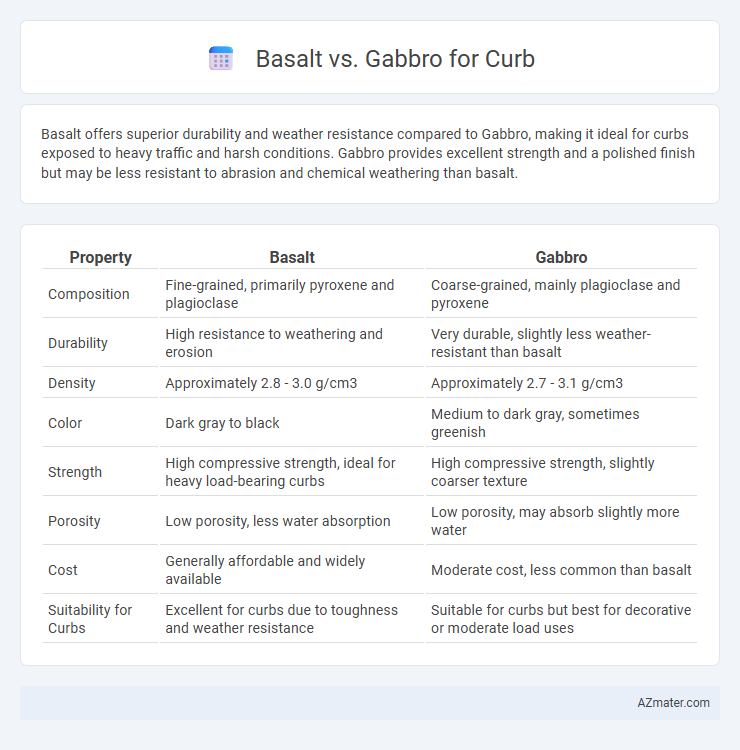Basalt offers superior durability and weather resistance compared to Gabbro, making it ideal for curbs exposed to heavy traffic and harsh conditions. Gabbro provides excellent strength and a polished finish but may be less resistant to abrasion and chemical weathering than basalt.
Table of Comparison
| Property | Basalt | Gabbro |
|---|---|---|
| Composition | Fine-grained, primarily pyroxene and plagioclase | Coarse-grained, mainly plagioclase and pyroxene |
| Durability | High resistance to weathering and erosion | Very durable, slightly less weather-resistant than basalt |
| Density | Approximately 2.8 - 3.0 g/cm3 | Approximately 2.7 - 3.1 g/cm3 |
| Color | Dark gray to black | Medium to dark gray, sometimes greenish |
| Strength | High compressive strength, ideal for heavy load-bearing curbs | High compressive strength, slightly coarser texture |
| Porosity | Low porosity, less water absorption | Low porosity, may absorb slightly more water |
| Cost | Generally affordable and widely available | Moderate cost, less common than basalt |
| Suitability for Curbs | Excellent for curbs due to toughness and weather resistance | Suitable for curbs but best for decorative or moderate load uses |
Introduction to Basalt and Gabbro
Basalt and gabbro are both igneous rocks commonly used in curbing due to their durability and aesthetic appeal. Basalt is a fine-grained volcanic rock formed from rapidly cooled lava, known for its dark color and high density. Gabbro, on the other hand, is a coarse-grained intrusive rock formed from slow cooling magma beneath the Earth's surface, featuring a speckled appearance with visible mineral crystals.
Geological Origins of Basalt and Gabbro
Basalt and gabbro are both mafic igneous rocks originating from the slow and rapid cooling of magma, with basalt forming from rapid cooling of lava at the surface and gabbro crystallizing slowly beneath the Earth's crust. Basalt's fine-grained texture results from its volcanic origin, while gabbro's coarse-grained structure reflects its intrusive, plutonic formation. These geological origins impact their durability and texture, making basalt suitable for smooth, dense curbs and gabbro preferred where coarse, robust stone is desired.
Physical Properties Comparison
Basalt exhibits a fine-grained texture with high density and excellent durability, making it resistant to weathering and abrasion, ideal for curbs in heavy traffic areas. Gabbro has a coarse-grained structure with slightly lower density but superior compressive strength, providing robust support and longevity in curb applications. Both igneous rocks offer substantial hardness and low porosity, ensuring minimal water absorption and enhanced resistance to freeze-thaw cycles in outdoor environments.
Hardness and Durability for Curb Use
Basalt exhibits higher hardness with a Mohs rating around 6 to 7, making it exceptionally resistant to abrasion and ideal for high-traffic curbs. Gabbro, while also durable with a Mohs hardness near 6, tends to be slightly less resistant to surface wear compared to basalt, impacting its longevity under heavy vehicular stress. Both igneous rocks provide strong durability, but basalt's superior hardness contributes to longer-lasting curb installations in demanding urban environments.
Color and Aesthetic Differences
Basalt offers a deep, uniform black to dark gray color with a fine-grained texture, creating a sleek and modern appearance ideal for curbs. Gabbro displays a coarser grain with a more varied color palette, including dark greens, blues, and grays, giving curbs a natural and rugged aesthetic. The subtle color variations in Gabbro provide a dynamic look, while Basalt's consistent shading ensures a minimalist and contemporary curb design.
Workability and Fabrication Ease
Basalt exhibits superior workability compared to gabbro due to its finer grain size, which facilitates easier cutting and shaping for curb applications. Gabbro's coarse-grained texture presents challenges in fabrication, often requiring specialized tools and more labor-intensive processes. The dense, homogeneous structure of basalt ensures consistent performance and more precise tolerance adherence during curb manufacturing.
Weather Resistance and Longevity
Basalt offers superior weather resistance compared to gabbro, making it highly durable for curbs exposed to harsh environmental conditions such as freeze-thaw cycles and heavy rainfall. Gabbro, while dense and strong, is more susceptible to surface erosion and chemical weathering over time, which can reduce its longevity in outdoor applications. Choosing basalt for curbs ensures enhanced structural integrity and a longer lifespan in areas with fluctuating weather patterns.
Cost Comparison: Basalt vs Gabbro Curbs
Basalt curbs typically cost more than gabbro curbs due to basalt's higher density and durability, which contributes to longer lifespan and reduced maintenance expenses. Gabbro, being more abundant and easier to quarry, offers a more budget-friendly option for curb installations, though it may require more frequent repairs over time. Choosing between basalt and gabbro curbs depends on balancing upfront material costs against the long-term structural performance and maintenance needs.
Environmental Impact and Sustainability
Basalt and gabbro, both igneous rocks, offer durable and eco-friendly options for curbs due to their natural abundance and low processing requirements. Basalt's fine-grained structure allows for efficient quarrying with minimal waste, resulting in a lower carbon footprint compared to synthetic materials. Gabbro's coarse-grained texture supports long-lasting installations that reduce the need for frequent replacements, promoting sustainability through extended lifecycle use.
Best Choice: Basalt or Gabbro for Curbs?
Basalt is the best choice for curbs due to its high durability, fine-grained texture, and resistance to weathering and abrasion, ensuring long-lasting performance in urban environments. Gabbro, while also durable, has a coarser texture and may be less resistant to surface wear under heavy traffic conditions. The dense composition of basalt provides superior structural integrity and aesthetic appeal for curb installations compared to gabbro.

Infographic: Basalt vs Gabbro for Curb
 azmater.com
azmater.com